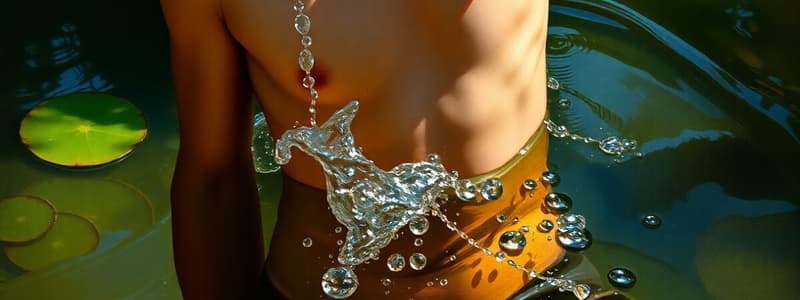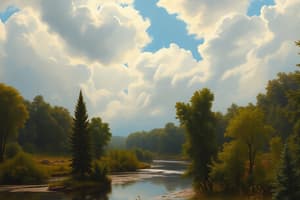Podcast
Questions and Answers
Which of the following is considered the largest reservoir of fresh water?
Which of the following is considered the largest reservoir of fresh water?
- Lakes
- Oceans
- Rivers
- Glaciers (correct)
What process involves water changing from liquid to gas at ambient temperatures?
What process involves water changing from liquid to gas at ambient temperatures?
- Evaporation (correct)
- Infiltration
- Precipitation
- Condensation
What is the term for the geographic area drained by a river and its tributaries?
What is the term for the geographic area drained by a river and its tributaries?
- Aquifer
- Wetland
- Watershed (correct)
- Reservoir
What percentage of the Earth's surface is covered by oceans?
What percentage of the Earth's surface is covered by oceans?
What drives the motion of water in the water cycle?
What drives the motion of water in the water cycle?
What is the largest reservoir of usable fresh water?
What is the largest reservoir of usable fresh water?
What percentage of water loss can cause death in humans?
What percentage of water loss can cause death in humans?
What percentage of the world's water is readily usable fresh water?
What percentage of the world's water is readily usable fresh water?
What is the primary source of water for rural homeowners in the U.S.?
What is the primary source of water for rural homeowners in the U.S.?
What is the term for locations where surface water infiltrates the ground?
What is the term for locations where surface water infiltrates the ground?
Which of the following is a common use of rivers?
Which of the following is a common use of rivers?
What is the approximate water requirement for one loaf of bread?
What is the approximate water requirement for one loaf of bread?
Flashcards
Water Reservoirs
Water Reservoirs
Natural locations on Earth where water is stored (oceans, glaciers, groundwater, lakes, etc).
Water (Hydrologic) Cycle
Water (Hydrologic) Cycle
Continuous movement of water between oceans, atmosphere, land, and biosphere.
Evaporation
Evaporation
Process where water changes from liquid to gas, purifying it by leaving ions behind.
Condensation
Condensation
Signup and view all the flashcards
Precipitation
Precipitation
Signup and view all the flashcards
River Discharge
River Discharge
Signup and view all the flashcards
Drainage Basin (Watershed)
Drainage Basin (Watershed)
Signup and view all the flashcards
Reservoirs (Artificial Lakes)
Reservoirs (Artificial Lakes)
Signup and view all the flashcards
Groundwater
Groundwater
Signup and view all the flashcards
Pore Space
Pore Space
Signup and view all the flashcards
Recharge Areas
Recharge Areas
Signup and view all the flashcards
Aquifer
Aquifer
Signup and view all the flashcards
Water Demand
Water Demand
Signup and view all the flashcards
Freshwater
Freshwater
Signup and view all the flashcards
Study Notes
Introduction
- Water, air, and food constitute people's most important natural resources
- Humans survive only a few minutes without oxygen, less than a week without water, but can survive about a month without food
- Water is essential for oxygen and food supply in the plant photosynthesis process
- Water is the most essential compound for all living things, including the human body
- Human babies are approximately 75% water
- Adults are 60% water
- The brain is about 85% water
- Blood and kidneys are 83% water
- Muscles are 76% water
- Bones are 22% water
- Constant water loss occurs through perspiration
- About 2 liters of water per day should be consumed in temperate climates
- Up to 9.5 liters of water per day should be consumed in hot desert climates
- A Loss of 15% of body water usually causes death
- Earth is known as the Water Planet due to the abundance of liquid water
- Oceans cover about 70% of Earth's surface
- Approximately half of the Earth’s surface is obscured by clouds
- The planet holds about 1.4 billion cubic kilometers (km3) of water, equivalent to about 200 billion liters per person
- Earth's water could cover the United States to a depth of 145 km
- Over 97% of Earth’s water is seawater, which is too salty for drinking or irrigation
- Rivers and lakes contain less than 0.01% of the world’s water, but are the most commonly used water sources
- One crucial environmental goal is ensuring clean water access for everyone
- Water is a renewable resource that is difficult to destroy
- Evaporation and precipitation replenish freshwater supplies
- Water availability is complicated by its uneven distribution across the Earth
- Arid climates and densely populated areas cause water shortages, projected to worsen due to population growth and climate change
- Human activities worsen shortages by overuse and pollution
- Hundreds of millions lack safe drinking water
- Billions lack access to improved sanitation
- About two million people die every year from diarrheal diseases, 90% of these deaths occur among children under 5, which are easily preventable
Water Reservoirs and Water Cycle
- Water is the only common substance existing naturally as a solid, liquid, or gas
- Water is distributed in water reservoirs
- Oceans are the largest reservoirs at 97% of all water, but too saline for human uses
- Ice caps and glaciers are the largest freshwater reservoirs, inconveniently located in Antarctica and Greenland
- Shallow groundwater is the largest reservoir of usable fresh water
- Rivers and lakes are the most heavily used water resources but represent a tiny amount of the world’s water
- If all the world’s water was the size of 1 gallon
- Freshwater would be about 1/3 cup
- Readily usable fresh water would be 2 tablespoons
- The hydrologic cycle shows the movement of water through oceans, atmosphere, glaciers, groundwater, lakes, rivers, and biosphere
- Solar energy and gravity drive the water cycle
- The water cycle involves water moving from bodies of water to the atmosphere through evaporation, forming clouds, and falling back to water and land as precipitation
- Land water returns to the ocean through surface runoff, rivers, glaciers, and subsurface groundwater flow, or back to the atmosphere by evaporation or transpiration
Water Salinity
- An important part of the water cycle concerns salinity, which is the abundance of dissolved ions in water
- Saltwater in oceans has high salinity, about 35,000 mg of dissolved ions per liter of seawater
- Evaporation is a distillation process that produces nearly pure water with almost no dissolved ions
- Water vaporizes and leaves dissolved ions in the original liquid phase
- Condensation forms clouds and precipitation
- Rainwater that falls onto land dissolves minerals in rock and soil which increases salinity
- Most lakes, rivers, and near-surface groundwater are freshwater
Primary Fresh Water Resources: Precipitation
- Precipitation levels vary globally, affecting freshwater availability
- More precipitation falls near the equator, while less precipitation tends to fall near 30 degrees north and south latitude, where the world’s largest deserts are located
- Rainfall and climate patterns are related to global wind circulation cells
- Intense sunlight at the equator heats the air, causing it to rise and cool, which decreases the air mass's ability to hold water vapor, resulting in rainstorms
- Around 30 degrees north and south latitude, descending air produces warmer air, which increases its ability to hold water vapor, resulting in dry conditions
- Both dry air conditions and warm temperatures favor evaporation
- Global precipitation and climate patterns are affected by the size of continents, major ocean currents, and mountains
Surface Water Resources: Rivers, Lakes, Glaciers
- Flowing water from rain and melted snow on land enter river channels by surface runoff and groundwater seepage
- River discharge describes the volume of water moving through a river channel over time
- The relative contributions of surface runoff vs. groundwater seepage to river discharge depend on precipitation patterns, vegetation, topography, land use, and soil characteristics
- River discharge increases soon after a heavy rainstorm due to surface runoff
- The steady normal flow of river water is mainly from groundwater discharging into the river
- Gravity pulls river water downhill toward the ocean
- The moving water of a river erodes soil particles and dissolves minerals
- Groundwater contributes a large amount of dissolved minerals in river water
- The geographic area drained by a river and its tributaries is called a drainage basin or watershed
- The Mississippi River drainage basin includes approximately 40% of the U.S
- Rivers are an important water resource for cropland irrigation and drinking water for many cities around the world
- Rivers with international water supply disputes include the Colorado, Nile, Euphrates, Ganges, and Jordan
- Lakes are a freshwater source, replenished from surface runoff and groundwater discharge
- Lakes are short-lived geologically because they are constantly filling with sediment supplied by incoming rivers
- Lakes form from:
- Glaciation
- Recent tectonic uplift
- Volcanic eruptions
- Artificial lakes (reservoirs) formed by damming rivers
- Climate changes can significantly modify a lake's size
- During the last Ice Age, the climate in the western U.S. changed and caused more than 100 large lakes to disappear
- The Great Salt Lake in Utah is a remnant of Lake Bonneville
- Glaciers represent the largest freshwater reservoir, but are not used as a water source due to their remote locations
- Melting glaciers provide a natural source of river water and groundwater
- During the last Ice Age, glaciers contained 50% more water, leading to about 100 m lower sea levels
- Sea level has been rising over the past century due to melting glaciers
- Continued warming will cause additional sea level rise
Groundwater Resources
- Groundwater is a much larger usable fresh water reservoir than rivers and lakes combined
- Groundwater is a particularly important resource in arid climates
- Groundwater is the primary water source for rural homeowners, providing 98% of the US water demand
- Groundwater is located in pore space between mineral grains and fractures in subsurface earth materials
- Most groundwater originates from rain or snowmelt infiltrating the ground and moving downward to the saturated zone
- Other sources of groundwater include seepage from surface water, surface water pumped into the ground, irrigation, and wastewater treatment systems
- Recharge areas are locations where surface water infiltrates the ground rather than running into rivers or evaporating
- Wetlands are an example of recharge areas
- A large area of subsurface, porous rock holding water is called an aquifer
- Aquifers are commonly drilled, with wells installed for agriculture and personal use
Water Use in the U.S. and World
- People require water to produce food, energy, and mineral resources
- One tomato = 11.4 liters
- One kilowatt-hour of electricity = 79.5 liters
- One loaf of bread = 568 liters
- One pound of beef = 6056.6 liters
- One tonne of steel = 238,480.9 liters
- Humans require only 3.8 liters per day to survive
- A typical Canadian uses approximately 466 liters per day, including cooking, washing, flushing, bathing, and commercial/industrial uses provided by public utilities
- An area's water demand is a function of its population and other uses of water
Studying That Suits You
Use AI to generate personalized quizzes and flashcards to suit your learning preferences.




